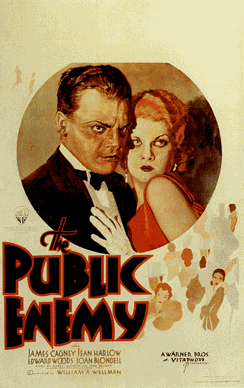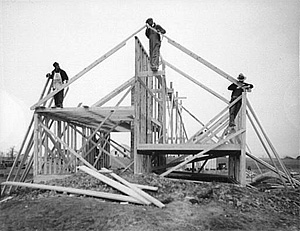Films are the reflections of society. Whenever there is
a societal shift, the changes can be seen in film; these changes in films are
film movements. One of the most influential film movements that has
continued its legacy is Film Noir.
What is Film Noir? When did Film Noir begin? Some
critics have claimed that Film Noir is the successor of the American gangster
films prevalent in the 1920s to 1930s (Hayward, 2013). The emergence of gangster film is due to the instability of socio-economy during the period of 1920s –
1930s. The act of gangsterism rose during the desperate times of the working
class trying to achieve the American Dream. It all started from the American
hard-boiled fiction that expresses the depression during that time through violence
(Beinsen, 2005, p.17). Due to the moral panic state, the classic age of
gangster films came to a halt. The Hays code was then represented to restrict
the representation of crime and violence as the genre needed to be altered to
emphasize on the triumph of the law over the outlaws. Thanks to the
implementation of Hays Code, criminals were no longer allowed to occupy the
central position in films which had seemingly reduced the violence shown in
gangster films (Browne, 2000, p. 81). Consequently, the emergence of sub genres
such as detective films and private investigators helps in the making of film
noir.
In the 1930s, from the
series of French translation of detective fiction of Marcel Duhamel’s Serie
Noire, the term Film Noir was emerged (Lanzoni, 2004, p. 170). Through the
influence of the German film, the French industry then adapts the dark ‘poetic
realism’ which establishes Film Noir (Biesen, 2005, p. 16). Due to World War
II, it left a great depression and caused the heavy numbers of civilian deaths
(Miller & Commager, 2001, p. 14). However, after the World War II ended,
the French enjoyed Film Noir like Double Indemnity (1944), Maltese Falcon
(1941) and Laura (1944).
Example of Film Noir:
 |
| Double Indemnity (1944) by Billy Wilder |
 |
| Laura (1944) by Otto Preminger |
_02.jpg) |
| Maltese Falcon (1941) by John Huston |
Film Noir is made to reflect the intersection of several
socio-economic and socio-political trauma of the emergence of Depression,
entrance of World War II, post-war upheaval of social norms, Cold War tensions
and threats of a nuclear holocaust (Renzi, 2006, p. 19). The Cold War had
influenced the psychology of the Film Noir that was shown in the film cinema in
France. Since it adapted the psychology of the people of the war era, the
French can relate to through the social norms that they went through. Film Noir
also has become an instrument to make a realization of the oppression visible.
The Great Depression. Destitute pea pickers in California. Mother of seven children. (Circa Febuary, 1936). ( Picture courtesy of the National Archives and Records Administration).
In 1946, Nino
Frank coined the term Film Noir. In his essay,‘ A New Type of Detective Story’
(Frank 1995), Nino Frank suggested Film Noir an “enigma to be solved” a
characteristic of Film Noir which turned into a crime film during the post war
period (Luhr, 2012, p. 195). He had analyzed the film through his experience in
the post-war era and contributed to Film Noir by understanding the film through
its characteristic with his surroundings.
1940s - 1960s
At first, Film Noir was seen as a successor of Gangsters genre films and crime thrillers for its similar elements. However, Film Noir deviates from its original perceived style; that falls under the detective films, murder mysteries, domestics, melodramas or social problems films as it resonates its dark styles to other genre films such as Western films (Luhr, 2012, p.22). Noir films and Western films share similar characteristics of the protagonist such as being morally challenged and violent hence leading to further exploration of Film Noir styles in Western films (Hayward, 2013, p.423). The first Western Noir film is known to be Pursued (Walsh, 1947) which explicitly show both characteristics of both Noir and Western; where the theme depicts a noir film and the setting is in the West.
Additionally, the themes of Film Noir films seems to be much darker than the Classic Hollywood films as they deviate from the cliche Hollywood "Happy Endings" (Luhr, 2012, p.25). The darker themes and tones in Film Noir depict the social conditions of the postwar anxiety and paranoia, individually and nationally. This was caused by the movement of women to the workforce and their empowerment during wartime when men had gone to war. When the men returned home from war, they felt disoriented as the women took over their place in the workforce. The darker tone of Film Noir was enhanced by the German Expressionist elements employed by the German filmmakers when they migrated to America during the instability of politics in Germany (Hayward, 2013, p. 149 - 150).
President Roosevelt launched programs to spur housing construction during the Depression. Here is a man building a house in 1935.
Most 1940s Noir films revolved around individual psychology and has developed into society affairs towards beginning of 1950s. The changed from the narratives involving the Private Eye to the law enforcers/organizations is to reinforce the American Dream; back to a place where the men are in control of the social sphere again and also to show the progress of rebuilding the country (Luhr, 2012).
Also, thanks to the emergence of Italian Neorealism in mid 1940s, Film Noir had adapted some “realism” characteristics from late 1940s to early 1950s. The noir films were made to look more documentary-like without losing its German Expressionist characteristics (Luhr, 2012, p. 36).
1960s onwards
In the year of 1960s, Film Noir undergoes the process of transformation in Hollywood. American culture sees a deep change in the younger generation that has distinguished the counterculture. The baby boomers generation from the post-World War II, rebelliously go against their parent’s values and the World War II generation. The post-war affluence has caused major social change in the society while the embedded patriarchal structures are attacked. This phenomenon is highly noticeable in the student revolutions in year 1968. Later on, the outbreak of the social strain arises regarding the Vietnam War, Watergate and the revolt of various movements against the policies and laws. The human’s right struggle such as women’s right, skin’s colour, various national and ethnic groups, gays and lesbians (Luhr, 2012, p. 42). This movement has lifted up various kind of restriction and this is the time where filmmakers rise.
Also, thanks to the emergence of Italian Neorealism in mid 1940s, Film Noir had adapted some “realism” characteristics from late 1940s to early 1950s. The noir films were made to look more documentary-like without losing its German Expressionist characteristics (Luhr, 2012, p. 36).
1960s onwards
In the year of 1960s, Film Noir undergoes the process of transformation in Hollywood. American culture sees a deep change in the younger generation that has distinguished the counterculture. The baby boomers generation from the post-World War II, rebelliously go against their parent’s values and the World War II generation. The post-war affluence has caused major social change in the society while the embedded patriarchal structures are attacked. This phenomenon is highly noticeable in the student revolutions in year 1968. Later on, the outbreak of the social strain arises regarding the Vietnam War, Watergate and the revolt of various movements against the policies and laws. The human’s right struggle such as women’s right, skin’s colour, various national and ethnic groups, gays and lesbians (Luhr, 2012, p. 42). This movement has lifted up various kind of restriction and this is the time where filmmakers rise.
The post-war affluence:
 |
| May 1968 events in France |
Film Noir was almost forgotten during these chaotic times but
managed to return and gave an impact to the film industry later on in 1960s.
The revival of film noir however occurred within an historical and industrial
context far broader than the genre (Luhr, 2012, p. 42). Classical Hollywood was
dying out at the same time during the emergence of Film Noir but the Hollywood
genres managed to restore its popularity not only in US but, in various
national cinemas. The revivals often lead to the existing popular films that
emphasize the nostalgic tone (Luhr, 2012, p. 42). The remake and revival of
such films can be seen in film such as The
Curse of Frankenstein (1957) and The horror of Dracula (1958). During this period of time, film
noir appeared significantly in most of the national cinemas. The most
significant film with the influences of French New Wave is Francois Truffaut’s Shoot the Piano Player (1962) or The Bride Wore Black (1968) or the Jean-Luc Godard’s Breathless (1959) or Alpaville (1965) (Luhr, 2012, p. 42).
 |
| The Horror of Dracula (1958) by Terence Fisher. |
Famous French new wave director:
 |
| Francois Truffaut. Director of Shoot the Piano Player (1962) and The Bride Wore Black (1968). |
 |
| Jean-Luc Godard. Director of Breathless (1959) and Alpaville (1965). |
Old Hollywood genres revived during the time when film discourse underwent growing internationalization and academicization. This process has given the general public easy access to film history. Moreover, the film cultures has rapidly increased from 1950s in film journal, cine-club and film festivals that leads to intellect accumulation of the international art cinemas, for directors such as Federico Fellini, Ingmar Bergman, Michelangelo Antonioni, Jean-Luc Godard, and Akira Kurosawa. The first generation of directors such as Francis Ford Coppola, Martin Scorsese, Steven Spielberg, and George Lucas were trained in film schools in the 1970s where they actively engaged in old genres in a new idea and nostalgic way (Luhr, 2012). This phenomenon and the influential French critics of a French film magazine, Cahiers du Cinema provides film noir with a critical boost. Cahiers du Cinema argues that film should reflect a director’s individual styles and element, for instance, director like Howard Hawks, Orson Welles, Samuel Fuller and Fritz Lang that had produced major forgotten works in film noir (Luhr, 2012, p. 44). This gave an impact in Hollywood film as each of the film directed by auteurist director, contains highly visible of noir elements.
Besides that, the Cashier du Cinema's writers such as Francois Truffant and Jean Luc Goddard were criticizing the French film making industry for it's avant garde aesthetics that has made the film industry dead
(Bordwell & Thompson, 2013, p. 486). As mention above, the critics felt that some American directors were auteurs as they each leave their mark in their films. This fascination can also be due to the fact that the French were bombarded with American films after the war. Consequently, their admiration for the American cinema has taken some Film Noir elements to their own works. The film Breathless (Goddard, 1960) which is the first French New Wave film and also Jean Luc Goddard's directing debut has some Noir elements in it. He has intended to pay homage to the 1940s American films (noir films) in his film, Breathless with a new twist. In Breathless (Goddard, 1960) the anti-hero, Michel has a habit of touching his lips, as Humphrey Bogart - a gangster and noir film actor - does (Bordwell & Thompson, 2013). Besides that, there is also the presence of a femme fatale, Patricia that has lead Michel to his death in the end.
Example of French film magazine:
 |
| Cahiers du Cinema. |
Example of neo noir:
 |
| Psycho (1960) by Alfred Hitchcock |
 |
| Kill Me Again (1989) by John Dahl. |
Example of Tech Noir:
 |
| Radioactive Dreams (1986) by Albert Pyun. |
Here are few Film Noir Directors:
 |
| From Left: Otto Preminger (1905 -1986), Fritz Lang (1890 - 1976), John Huston (1906 -1987), Billy Wilder (1906 -2002). |







0 comments:
Post a Comment